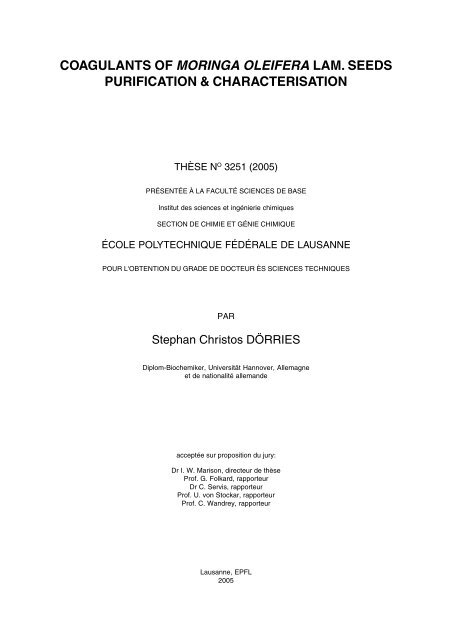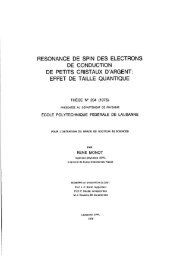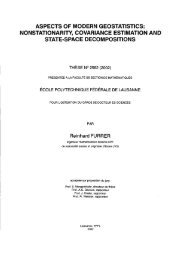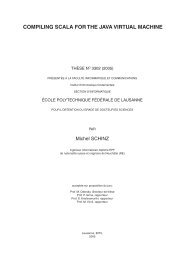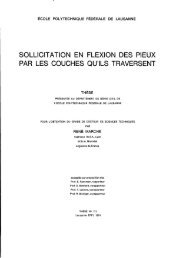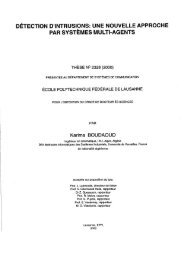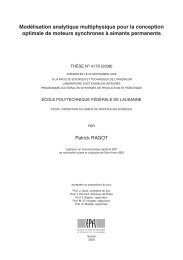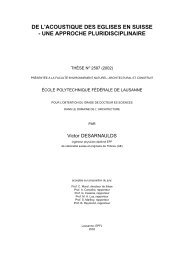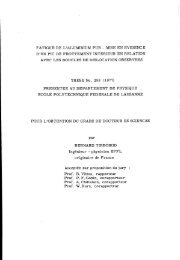coagulants of moringa oleifera lam. seeds purification ... - EPFL
coagulants of moringa oleifera lam. seeds purification ... - EPFL
coagulants of moringa oleifera lam. seeds purification ... - EPFL
Create successful ePaper yourself
Turn your PDF publications into a flip-book with our unique Google optimized e-Paper software.
COAGULANTS OF MORINGA OLEIFERA LAM. SEEDS<br />
PURIFICATION & CHARACTERISATION<br />
THÈSE N O 3251 (2005)<br />
PRÉSENTÉE À LA FACULTÉ SCIENCES DE BASE<br />
Institut des sciences et ingénierie chimiques<br />
SECTION DE CHIMIE ET GÉNIE CHIMIQUE<br />
ÉCOLE POLYTECHNIQUE FÉDÉRALE DE LAUSANNE<br />
POUR L'OBTENTION DU GRADE DE DOCTEUR ÈS SCIENCES TECHNIQUES<br />
PAR<br />
Stephan Christos DÖRRIES<br />
Diplom-Biochemiker, Universität Hannover, Allemagne<br />
et de nationalité allemande<br />
acceptée sur proposition du jury:<br />
Dr I. W. Marison, directeur de thèse<br />
Pr<strong>of</strong>. G. Folkard, rapporteur<br />
Dr C. Servis, rapporteur<br />
Pr<strong>of</strong>. U. von Stockar, rapporteur<br />
Pr<strong>of</strong>. C. Wandrey, rapporteur<br />
Lausanne, <strong>EPFL</strong><br />
2005
Table <strong>of</strong> Contents<br />
<strong>of</strong> Moringa <strong>oleifera</strong> Lam. Seeds . . . . . . . . . . 1<br />
Coagulants<br />
Water Supply . . . . . . . . . . . . . . . . . . . . . . . . . . . . . . . . . . . . 2<br />
Global<br />
Treatment using Primary Coagulants . . . . . . . . . . . . . . . . . .3<br />
Water<br />
Flocculants . . . . . . . . . . . . . . . . . . . . . . . . . . . . . . . . .4<br />
Commercial<br />
. . . . . . . . . . . . . . . . . . . . . . . . . . . . . . . . . . . . . . . . . . . . . . . . . 6<br />
Aim<br />
. . . . . . . . . . . . . . . . . . . . . . . . . . . . . . . . . . . . . . . . . . . . . . 7<br />
References<br />
<strong>of</strong> Flocculating Proteins<br />
Extraction<br />
M.<strong>oleifera</strong> Seeds . . . . . . . . . . . . . . . . . . . . . . . . . . . . 9<br />
from<br />
. . . . . . . . . . . . . . . . . . . . . . . . . . . . . . . . . . . . . . . . . . . . . . . 10<br />
Abstract<br />
. . . . . . . . . . . . . . . . . . . . . . . . . . . . . . . . . . . . . . . . . . . . 10<br />
Introduction<br />
and Methods . . . . . . . . . . . . . . . . . . . . . . . . . . . . . . . . . . . .12<br />
Materials<br />
Extraction . . . . . . . . . . . . . . . . . . . . . . . . . . . . . . . . . . . . . . . 12<br />
Seed<br />
Salt Solution: . . . . . . . . . . . . . . . . . . . . . . . . . . . . . . . . . 12<br />
Multiple<br />
Extraction Buffer: . . . . . . . . . . . . . . . . . . . . . . . . . . . . . . . 12<br />
Protein<br />
NaCl: . . . . . . . . . . . . . . . . . . . . . . . . . . . . . . . . . . . . . . . . . . . .13<br />
1M<br />
Water: . . . . . . . . . . . . . . . . . . . . . . . . . . . . . . . . . . 13<br />
Demineralised<br />
Methods . . . . . . . . . . . . . . . . . . . . . . . . . . . . . . . . . . . .13<br />
Analytical<br />
. . . . . . . . . . . . . . . . . . . . . . . . . . . . . . . . . . . . . . 13<br />
Chromatography<br />
/ Western Blotting . . . . . . . . . . . . . . . . . . . . . . . . . . . 13<br />
SDS-PAGE<br />
and Discussion . . . . . . . . . . . . . . . . . . . . . . . . . . . . . . . . . . . 14<br />
Results<br />
Extraction procedures . . . . . . . . . . . . . . . . . . . . . . . . . . 14<br />
Different<br />
<strong>of</strong> Protein Content during Storage . . . . . . . . . . . . . . . . 19<br />
Evolution<br />
<strong>of</strong> Thermo-Precipitation . . . . . . . . . . . . . . . . . . . . . . . . . . . 23<br />
Effect<br />
. . . . . . . . . . . . . . . . . . . . . . . . . . . . . . . . . . . . . . . . . . . . 24<br />
Conclusions<br />
References . . . . . . . . . . . . . . . . . . . . . . . . . . . . . . . . . . . . . . . . . . . . . 27<br />
<strong>of</strong> M.<strong>oleifera</strong> Seed Proteins<br />
Purification<br />
Sequence Determination . . . . . . . . . . . . . . . . . . . . . . 29<br />
for<br />
. . . . . . . . . . . . . . . . . . . . . . . . . . . . . . . . . . . . . . . . . . . . . . . 30<br />
Abstract<br />
. . . . . . . . . . . . . . . . . . . . . . . . . . . . . . . . . . . . . . . . . . . . 30<br />
Introduction<br />
Strategies . . . . . . . . . . . . . . . . . . . . . . . . . . . . . . . . . . 30<br />
Purification<br />
. . . . . . . . . . . . . . . . . . . . . . . . . . . . . . . . . . . . . . . . . . 32<br />
SDS-PAGE<br />
<strong>of</strong> Proteins upon Extraction . . . . . . . . . . . . . . . . . . . 32<br />
Modification<br />
and Methods . . . . . . . . . . . . . . . . . . . . . . . . . . . . . . . . . . . .34<br />
Materials<br />
Extraction . . . . . . . . . . . . . . . . . . . . . . . . . . . . . . . . . . . . . . . 34<br />
Seed<br />
. . . . . . . . . . . . . . . . . . . . . . . . . . . . . . . . . . . . . . 34<br />
Chromatography<br />
. . . . . . . . . . . . . . . . . . . . . . . . . . . . . . . . . . . . . . . . . . . . 34<br />
Analytics<br />
. . . . . . . . . . . . . . . . . . . . . . . . . . . . . . . . . . . . . . . . . . 35<br />
SDS-PAGE<br />
Protein . . . . . . . . . . . . . . . . . . . . . . . . . . . . . . . . . . . . . . . . . 35<br />
Total<br />
Spectrometry (MS) . . . . . . . . . . . . . . . . . . . . . . . . . . . . . . . 35<br />
Mass<br />
and Discussion . . . . . . . . . . . . . . . . . . . . . . . . . . . . . . . . . . . 36<br />
Results<br />
Reverse Phase HPLC . . . . . . . . . . . . . . . . . . . . 36<br />
Semi-Preparative<br />
iii
iv<br />
Reverse Phase Chromatography . . . . . . . . . . . . . . . . 40<br />
Preparative<br />
<strong>of</strong> the Thermo-Precipitation Step . . . . . . . . . . . . . . . . . 45<br />
Influence<br />
Extraction Buffer . . . . . . . . . . . . . . . . . . . . . . . . . . . . . . . 48<br />
Protein<br />
<strong>of</strong> Non-Reduced Main Protein Component Prior<br />
Pooling<br />
Reduction. . . . . . . . . . . . . . . . . . . . . . . . . . . . . . . . . . . . . . . . . 52<br />
to<br />
Theoretical Plate Number . . . . . . . . . . . . . . . . . . . . . . 55<br />
Increased<br />
. . . . . . . . . . . . . . . . . . . . . . . . . . . . . . . . . . . . . . . . . . . . 59<br />
Conclusions<br />
Strategy . . . . . . . . . . . . . . . . . . . . . . . . . . . . . . . . . . 59<br />
Purification<br />
Characteristics . . . . . . . . . . . . . . . . . . . . . . . . . . . . . . . . . 60<br />
Protein<br />
Modification and Non-Proteinaceous Components . . . . . 61<br />
Protein<br />
References . . . . . . . . . . . . . . . . . . . . . . . . . . . . . . . . . . . . . . . . . . . . . 63<br />
<strong>of</strong> Non-Proteinaceous Components<br />
Characterisation<br />
in M.<strong>oleifera</strong> Extracts . . . . . . . . . . . . . . . . . . . . 65<br />
Present<br />
. . . . . . . . . . . . . . . . . . . . . . . . . . . . . . . . . . . . . . . . . . . . . . . 66<br />
Abstract<br />
. . . . . . . . . . . . . . . . . . . . . . . . . . . . . . . . . . . . . . . . . . . . 66<br />
Introduction<br />
<strong>of</strong> Secondary Metabolites that Interfere<br />
Presence<br />
Protein Purification from Seeds . . . . . . . . . . . . . . . . . . . . . . 66<br />
with<br />
Compounds . . . . . . . . . . . . . . . . . . . . . . . . . . . . . . . . . . 66<br />
Phenolic<br />
derivatives . . . . . . . . . . . . . . . . . . . . . . . . . . . . . . . 67<br />
Glucosinolate<br />
<strong>of</strong> Phenolics and Isothiocyanates<br />
Influence<br />
the Physicochemical Properties <strong>of</strong> Proteins . . . . . . . . . . . . . . 68<br />
on<br />
<strong>of</strong> Secondary Metabolites in M.<strong>oleifera</strong> seed extracts 71<br />
Determination<br />
and Methods . . . . . . . . . . . . . . . . . . . . . . . . . . . . . . . . . . . 71<br />
Materials<br />
. . . . . . . . . . . . . . . . . . . . . . . . . . . . . . . . . . . . . . . . . . . 71<br />
Chemicals<br />
material . . . . . . . . . . . . . . . . . . . . . . . . . . . . . . . . . . . . . . . . 71<br />
Plant<br />
and isolation <strong>of</strong> 4(-α-L-rhamnopyranosyloxy)-<br />
Extraction<br />
(4RBGLS) . . . . . . . . . . . . . . . . . . . . . . . . . . 71<br />
benzylglucosinolate<br />
<strong>of</strong> 4RBGLS . . . . . . . . . . . . . . . . . . . . . . . . . . . 72<br />
Re-crystallization<br />
<strong>of</strong> isolated 4RBGLS . . . . . . . . . . . . . . . . . . . . . 72<br />
Characterization<br />
and isolation <strong>of</strong> 4-(α-L-rhamnopyranosyloxy)-<br />
Preparation<br />
(4RBITC) . . . . . . . . . . . . . . . . . . . . . . . . . 72<br />
benzylisothiocyanate<br />
Extractions . . . . . . . . . . . . . . . . . . . . . . . . . . . . . . . . . . . . . . 73<br />
Seed<br />
Extraction Procedure for All Different Media . . . . . . . 73<br />
Modified<br />
Protein Extraction Procedures . . . . . . . . . . . . . . . . . . . . 73<br />
Original<br />
methods . . . . . . . . . . . . . . . . . . . . . . . . . . . . . . . . . . . . . . . 73<br />
HPLC<br />
<strong>of</strong> secondary metabolites . . . . . . . . . . . . . . . . . . . 73<br />
Quantification<br />
and Discussion . . . . . . . . . . . . . . . . . . . . . . . . . . . . . . . . . . . 74<br />
Results<br />
<strong>of</strong> Standards for Glucosinolates<br />
Preparation<br />
Isothiocyanates present in M.<strong>oleifera</strong> . . . . . . . . . . . . . . . . . . 74<br />
and<br />
Analysis <strong>of</strong> Different Extraction Media . . . . . . . . . . 76<br />
Qualitative<br />
<strong>of</strong> Secondary Metabolites in Extracts<br />
Quantification<br />
M.<strong>oleifera</strong> <strong>seeds</strong> . . . . . . . . . . . . . . . . . . . . . . . . . . . . . . . . . . . . 84<br />
<strong>of</strong><br />
. . . . . . . . . . . . . . . . . . . . . . . . . . . . . . . . . . . . . . . . . . . . 85<br />
Conclusions<br />
<strong>of</strong> the Results in Regard to Protein Extraction . . . . . 86<br />
Importance<br />
. . . . . . . . . . . . . . . . . . . . . . . . . . . . . . . . . . . . 87<br />
Acknowledgments<br />
References . . . . . . . . . . . . . . . . . . . . . . . . . . . . . . . . . . . . . . . . . . . . . 88
<strong>of</strong> Coagulating Activity <strong>of</strong> Different Compo-<br />
Measurement<br />
Present in M.<strong>oleifera</strong> Seed Extracts . . . . . . . . . . 91<br />
nents<br />
. . . . . . . . . . . . . . . . . . . . . . . . . . . . . . . . . . . . . . . . . . . . . . .92<br />
Abstract<br />
. . . . . . . . . . . . . . . . . . . . . . . . . . . . . . . . . . . . . . . . . . . . 92<br />
Introduction<br />
<strong>of</strong> Coagulation Efficiency . . . . . . . . . . . . . . . . . . . . . . . .92<br />
Testing<br />
<strong>of</strong> the Particle Concentration on<br />
Influence<br />
Coagulating Activity . . . . . . . . . . . . . . . . . . . . . . . . . . . . . . . .94<br />
the<br />
<strong>of</strong> colloid material for coagulation experiments . . . . . . . . 95<br />
Choice<br />
<strong>of</strong> the Coagulation Rate . . . . . . . . . . . . . . . . . . . . . 96<br />
Measurement<br />
<strong>of</strong> Coagulation and Flocculation . . . . . . . . . . . . . . . . . 97<br />
Definition<br />
and Methods . . . . . . . . . . . . . . . . . . . . . . . . . . . . . . . . . . . .99<br />
Materials<br />
. . . . . . . . . . . . . . . . . . . . . . . . . . . . . . . . . . . . . . . . . . .99<br />
Chemicals<br />
Seed Extracts . . . . . . . . . . . . . . . . . . . . . . . . . . . . . . . .99<br />
M.<strong>oleifera</strong><br />
Assay . . . . . . . . . . . . . . . . . . . . . . . . . . . . . . . . . . . .99<br />
Coagulation<br />
and Discussion . . . . . . . . . . . . . . . . . . . . . . . . . . . . . . . . . . 101<br />
Results<br />
Extraction Procedures . . . . . . . . . . . . . . . . . . . . . . . . . 106<br />
Different<br />
<strong>of</strong> Fractions prepared by Chromatographic separation<br />
Analysis<br />
Extracts . . . . . . . . . . . . . . . . . . . . . . . . . . . . . . . . . . . . . . . . . . 108<br />
<strong>of</strong><br />
extract . . . . . . . . . . . . . . . . . . . . . . . . . . . . . . . . . . 108<br />
Non-reduced<br />
after Reduction <strong>of</strong> the Sample . . . . . . . . . . . . . . . . . . 111<br />
Separation<br />
<strong>of</strong> Suspensions <strong>of</strong> Glassbeads and Bentonite . . . . . 114<br />
Flocculation<br />
. . . . . . . . . . . . . . . . . . . . . . . . . . . . . . . . . . . . . . . . . . . 116<br />
Conclusions<br />
activity <strong>of</strong> M.<strong>oleifera</strong> extracts . . . . . . . . . . . . . . . . . 117<br />
Coagulating<br />
. . . . . . . . . . . . . . . . . . . . . . . . . . . . . . . . . . . . . . . . . . . . 120<br />
References<br />
<strong>of</strong> M.<strong>oleifera</strong> Seed Proteins . . . . . . 123<br />
Characterisation<br />
. . . . . . . . . . . . . . . . . . . . . . . . . . . . . . . . . . . . . . . . . . . . . . 124<br />
Abstract<br />
. . . . . . . . . . . . . . . . . . . . . . . . . . . . . . . . . . . . . . . . . . . 124<br />
Introduction<br />
Proteins . . . . . . . . . . . . . . . . . . . . . . . . . . . . . . . . . . . . . . . . 126<br />
Seed<br />
and Methods . . . . . . . . . . . . . . . . . . . . . . . . . . . . . . . . . . . 131<br />
Materials<br />
. . . . . . . . . . . . . . . . . . . . . . . . . . . . . . . . . . . . . . . . . . 131<br />
Chemicals<br />
extraction and quantification . . . . . . . . . . . . . . . . . . . . . 131<br />
Protein<br />
Separation (prep. HPLC + Äkta) . . . . . . . . . . 132<br />
Chromatographic<br />
SDS PAGE / Western Blotting . . . . . . . . . . . . . . . . 132<br />
Tris-Tricine<br />
Protein Staining and Immuno Staining . . . . . . . . . 132<br />
Non-Specific<br />
Staining <strong>of</strong> Glycosylated Proteins . . . . . . . . . . . . . . . . . 132<br />
Specific<br />
. . . . . . . . . . . . . . . . . . . . . . . . . . . . . . . . . . . . 133<br />
MALDI/TOF-MS<br />
Mapping / Mass Mapping . . . . . . . . . . . . . . . . . . . . . . . 133<br />
Peptide<br />
and Discussion . . . . . . . . . . . . . . . . . . . . . . . . . . . . . . . . . . 134<br />
Results<br />
Sequences <strong>of</strong> Selected Protein Fractions . . . . . . . . . . . . . . . 134<br />
Tag<br />
molecular weight proteins present in oil body fractions . . . 135<br />
Low<br />
Separated by Reverse Phase Chromatography<br />
Proteins<br />
Sample Reduction . . . . . . . . . . . . . . . . . . . . . . . . . . . . . . . . 137<br />
after<br />
digest . . . . . . . . . . . . . . . . . . . . . . . . . . . . . . . . . . . . . . . 139<br />
Tryptic<br />
Digest . . . . . . . . . . . . . . . . . . . . . . . . . . . . . . . . . . 142<br />
Chymotryptic<br />
Immuno Detection <strong>of</strong> Proteins with Anti-Flo Antibodies . . . . . . 144<br />
v
vi<br />
. . . . . . . . . . . . . . . . . . . . . . . . . . . . . . . . . . . . . . . . . . . 146<br />
Conclusions<br />
<strong>of</strong> Purification <strong>of</strong> M.<strong>oleifera</strong> seed proteins . . . . . . . 146<br />
Difficulties<br />
<strong>of</strong> Isolated Fragments to Mo2.1 . . . . . . . . . . . . . . . . 146<br />
Homology<br />
Homologies <strong>of</strong> Mo2.1 with seed proteins . . . . . . . . . 147<br />
Sequence<br />
References . . . . . . . . . . . . . . . . . . . . . . . . . . . . . . . . . . . . . . . . . . . . 149<br />
<strong>of</strong> the Extraction Procedure . . . . . . . . . . . . . 151<br />
Scale-up<br />
. . . . . . . . . . . . . . . . . . . . . . . . . . . . . . . . . . . . . . . . . . . . . . 152<br />
Abstract<br />
. . . . . . . . . . . . . . . . . . . . . . . . . . . . . . . . . . . . . . . . . . . 152<br />
Introduction<br />
from Laboratory to Pilot Scale . . . . . . . . . . . . . . . . . . 154<br />
Transfer<br />
and Methods . . . . . . . . . . . . . . . . . . . . . . . . . . . . . . . . . . 156<br />
Materials<br />
. . . . . . . . . . . . . . . . . . . . . . . . . . . . . . . . . . . . . . . . . . 156<br />
Chemicals<br />
Cake Extraction . . . . . . . . . . . . . . . . . . . . . . . . . . . . . . . . 156<br />
Press<br />
Extraction . . . . . . . . . . . . . . . . . . . . . . . . . . . . . . . . . . . . . 156<br />
Batch<br />
. . . . . . . . . . . . . . . . . . . . . . . . . . . . . . . . . . . . . . . . . 156<br />
Percolation<br />
and Diafiltration . . . . . . . . . . . . . . . . . . . . . . . . . 156<br />
Ultrafiltration<br />
Scale . . . . . . . . . . . . . . . . . . . . . . . . . . . . . . . . . . . . 156<br />
Laboratory<br />
Scale . . . . . . . . . . . . . . . . . . . . . . . . . . . . . . . . . . . . . . . . . 157<br />
Pilot<br />
. . . . . . . . . . . . . . . . . . . . . . . . . . . . . . . . . . . . . . . . 157<br />
Diafiltration<br />
. . . . . . . . . . . . . . . . . . . . . . . . . . . . . . . . . . . . . . . . . . 158<br />
Analytics<br />
SDS-PAGE . . . . . . . . . . . . . . . . . . . . . . . . . . . . . . 158<br />
Tris-Tricine<br />
Determination (BCA & Bradford) . . . . . . . . . . . . . . . . . 158<br />
Protein<br />
and Discussion . . . . . . . . . . . . . . . . . . . . . . . . . . . . . . . . . . 159<br />
Results<br />
Separation . . . . . . . . . . . . . . . . . . . . . . . . . . . . . . . 159<br />
Solid-Liquid<br />
Concentration . . . . . . . . . . . . . . . . . . . . . . . . . . . . . . . . 161<br />
Product<br />
Extraction by Percolation . . . . . . . . . . . . . . . . . . . . . . . 164<br />
Protein<br />
. . . . . . . . . . . . . . . . . . . . . . . . . . . . . . . . . . . . . . . . . . . 169<br />
Conclusions<br />
Separation . . . . . . . . . . . . . . . . . . . . . . . . . . . . . . . 169<br />
Solid-Liquid<br />
Concentration . . . . . . . . . . . . . . . . . . . . . . . . . . . . . . . . 169<br />
Product<br />
Extraction . . . . . . . . . . . . . . . . . . . . . . . . . . . . . . . 172<br />
Solid-Liquid<br />
References . . . . . . . . . . . . . . . . . . . . . . . . . . . . . . . . . . . . . . . . . . . . 174<br />
<strong>of</strong> Moringa <strong>oleifera</strong> Lam. Seeds . . . . . . . . 175<br />
Coagulants<br />
Conclusions and Future Perspectives . . . . . . . . . . . . . . . . 176<br />
General<br />
References . . . . . . . . . . . . . . . . . . . . . . . . . . . . . . . . . . . . . . . . . . . . 181<br />
Figures and Tables . . . . . . . . . . . . . . . . . . . 183<br />
Additional<br />
3 - Characterisation <strong>of</strong> Non-Proteinaceous<br />
Chapter<br />
Present in M.<strong>oleifera</strong> Extracts . . . . . . . . . . . . . . . . . . 184<br />
Components<br />
Calculation <strong>of</strong> Secondary Metabolite Concentration from Signal<br />
Direct<br />
Areas Observed in Standard Protein HPLC Chromatograms 190<br />
Peak<br />
4 - Measurement <strong>of</strong> Coagulating Activity <strong>of</strong> Different Components<br />
Chapter<br />
in M.<strong>oleifera</strong> Seed Extracts . . . . . . . . . . . . . . . . . . . . . . . . 191<br />
Present<br />
change during coagulation<br />
Absorption<br />
a glass powder suspension . . . . . . . . . . . . . . . . . . . . . . . . . . . 195<br />
<strong>of</strong><br />
5 - Characterisation <strong>of</strong> M.<strong>oleifera</strong> Seed Proteins . . . . . . . 198<br />
Chapter
HPLC <strong>of</strong> Extract prepared<br />
Preparative<br />
Multiple Salt Solution from M.<strong>oleifera</strong> press cake. . . . . . 198<br />
with<br />
<strong>of</strong> Fractions for Sequence Analysis<br />
Preparation<br />
Reverse Phase HPLC <strong>of</strong> an Extract prepared<br />
by<br />
Multiple Salts Solution from M.<strong>oleifera</strong> Press Cake . . . . . 202<br />
with<br />
6 - Scale-up <strong>of</strong> the Extraction Procedure . . . . . . . . . . . . . . 205<br />
Chapter<br />
<strong>of</strong> the Diafiltration Device . . . . . . . . . . . . . . . . . . . . . . . . 205<br />
Setup<br />
. . . . . . . . . . . . . . . . . . . . . . . . . . . . . . . . . . . . . . . . . . . . . 205<br />
Reference<br />
. . . . . . . . . . . . . . . . . . . . . . . . . . . . . . . . . . . . . . . . . . 207<br />
Nomenclature<br />
. . . . . . . . . . . . . . . . . . . . . . . . . . . . . . . . . . . . . . . . . . 208<br />
Abbreviations<br />
Acids (Single Letter Code) . . . . . . . . . . . . . . . . . . . . . . . . . 209<br />
Amino<br />
Vitae . . . . . . . . . . . . . . . . . . . . . . . . . . . . . . . . . . . . . 211<br />
Curriculum<br />
Publications . . . . . . . . . . . . . . . . . . . . . . . . . . . . . . . . . . . . . . . . . 212<br />
vii
SUMMARY<br />
Water has been declared a human right by the United Nations, thus urging countries who have<br />
ratified the International Covenant on Economic, Social and Cultural Rights to ensure supply<br />
with drinking water for their populations 1 .<br />
However, supply <strong>of</strong> drinking water in developing countries underlies different constraints than<br />
those met in industrialized countries. An example is the dependency on treatment chemicals that<br />
may pose problems in these countries regarding importation and distribution 2 . In pioneering<br />
work in the Darfur region (Sudan) S.A.A. Jahn has instructed rural people how to use local nat-<br />
ural <strong>coagulants</strong>, that had been used traditionally by parts <strong>of</strong> the population, for the preparation<br />
<strong>of</strong> water for household use with special emphasis on the <strong>seeds</strong> <strong>of</strong> the Moringa <strong>oleifera</strong> tree 3 . The<br />
implementation <strong>of</strong> water supply for the population on the other hand demands centralized water<br />
treatment for villages and cities and thus traditional techniques will reach their limitations.<br />
The present work tries to identify and characterise the coagulating principle present in the <strong>seeds</strong><br />
and press-cake <strong>of</strong> M.<strong>oleifera</strong>, in order to produce quantities <strong>of</strong> a standardized coagulant that<br />
could be used in small treatment works. Therefore, different extraction methods, reported in the<br />
literature, are compared regarding extraction efficiency and composition. All extracts contained<br />
a large proteinaceous moiety, which differed from proteins described before as Mo 2.1 (floccu-<br />
lating proteins 4 ) in the way that two proteins were detected under reducing conditions, both not<br />
co-migrating with a synthetic protein having the amino acid sequence <strong>of</strong> Mo 2.1. Moreover a<br />
different group <strong>of</strong> proteins with higher molecular weight was only present during the first two<br />
days <strong>of</strong> storage <strong>of</strong> the liquid extract. An optimized extraction procedure is presented, resulting<br />
in a total protein yield <strong>of</strong> 40g/L.<br />
Separation <strong>of</strong> proteinaceous components present in the seed and press-cake extracts lead to the<br />
determination <strong>of</strong> relative molecular masses <strong>of</strong> two protein components present (4 and 8 kDa)<br />
which form a 12 kDa heterodimer under non-reducing conditions, such as those found in the<br />
raw extracts. Further evidence is presented that the number <strong>of</strong> different proteins present in the<br />
UN, Substantive issues arising in the implementation <strong>of</strong> the international covenant on economic, social<br />
1.<br />
cultural rights. 2002, United Nations, Economic and Social Council, Committee on Economic,<br />
and<br />
and Cultural Rights.<br />
Social<br />
Folkard, G. and J. Sutherland, Development <strong>of</strong> a naturally derived coagulant for water and wastewater<br />
2.<br />
Water Science and Technology: Water Supply, 2002. 2(5-6): p. 89-94.<br />
treatment.<br />
Jahn, S.A.A., Proper use <strong>of</strong> African natural <strong>coagulants</strong> for rural water supplies research in the Sudan<br />
3.<br />
a guide for new projects. 1986, Eschborn: Deutsche Gesellschaft für Technische Zusammenarbeit.<br />
and<br />
S. 541<br />
Gassenschmidt, U., et al., Isolation and Characterization <strong>of</strong> a Flocculating Protein from Moringa-<br />
4.<br />
Lam. Biochimica Et Biophysica Acta-General Subjects, 1995. 1243(3): p. 477-481.<br />
Oleifera<br />
ix
x<br />
Summary<br />
extracts using the reported techniques may be an artifact due to sample degradation, oxidation<br />
and reaction with non-proteinaceous substances present in the extracts.<br />
The presence <strong>of</strong> glucosinolates and <strong>of</strong> their derivatives that belong to the reactive group <strong>of</strong> iso-<br />
thiocyanates was show in the extracts <strong>of</strong> M.<strong>oleifera</strong> <strong>seeds</strong> and press-cake, thus increasing the<br />
risk <strong>of</strong> protein stability problems during storage <strong>of</strong> the potential product. Furthermore, a method<br />
for protein isolation which reduces interference <strong>of</strong> isothiocyanates has been developed for ex-<br />
traction from M.<strong>oleifera</strong>.<br />
In order to compare the coagulating activities <strong>of</strong> different components present in fractions after<br />
separation <strong>of</strong> the seed extracts a miniaturized assay has been developed. Highest coagulating<br />
activities were found for the 8 kDa protein chain. Partial sequencing <strong>of</strong> different preparations <strong>of</strong><br />
the 8 kDa chain indicated the presence <strong>of</strong> several forms <strong>of</strong> the protein having slight sequence<br />
differences. The protein chain is very similar to the published Mo 2.1 protein, but appears to<br />
contain 70 amino acid residues instead <strong>of</strong> the 60 residues reported for Mo 2.1. These results<br />
clearly indicate that the original protein Mo 2.1 is only a fragment <strong>of</strong> the proteins present in ex-<br />
tracts from M.<strong>oleifera</strong> <strong>seeds</strong>.<br />
Experiments for pilot scale production were conducted involving extraction <strong>of</strong> the coagulant<br />
from M.<strong>oleifera</strong> press cake. Different possible technologies for the preparation <strong>of</strong> coagulant<br />
from M.<strong>oleifera</strong> press-cake are compared. Difficulties were encountered in solid-liquid separa-<br />
tion after initial extraction, due to high solid loads and very slow settling, and during concen-<br />
tration <strong>of</strong> extracts by ultrafiltration. Alternatively tests for percolation <strong>of</strong> press-cake were<br />
carried out, which resulted in high extraction efficiencies. Finally an extraction process using<br />
sequential percolation with two different solvents, in order to separate glucosinolates and pro-<br />
teins is proposed, followed by a precipitating concentration step <strong>of</strong> the product.
ZUSAMMENFASSUNG<br />
Wasser ist von den Vereinten Nationen zu einem Menschenrecht erklärt worden, in der Absicht<br />
Staaten, die den Internationalen Pakt über wirtschaftliche, soziale und kulturelle Rechte<br />
ratifiziert haben, dazu zu bewegen, die Versorgung der Bevölkerung mit Trinkwasser zu<br />
gewährleisten 1 .<br />
Bei der Umsetzung dieses Ziels ist jedoch zu bedenken, dass die Trinkwasserversorgung in den<br />
armen Ländern anderen Beschränkungen unterliegt, als die für industrialisierte Nationen gilt.<br />
Die Abhängigkeit von Chemikalien zur Wasseraufbereitung beispielsweise, welche aus<br />
anderen Ländern importiert werden müssen, birgt die Gefahr von Unregelmässigkeiten bei der<br />
Lieferung 2 . S.A.A. Jahn versuchte, die Verwendung von natürlichen Flockungsmitteln<br />
(besonders der Samen des M.<strong>oleifera</strong> Baumes) zur Aufbereitung von Trinkwasser in der<br />
Landbevölkerung in der Region um Darfur (Sudan) mit einfachen Mitteln zu systematisieren 3 .<br />
Dem gegenüber verlangt die Umsetzung der Wasserversorgung der Bevölkerung eine<br />
zentralisierte Wasseraufbereitung zur Versorgung ganzer Dörfer und Städte, sodaß traditionelle<br />
Methoden nicht mehr ausreichen.<br />
Die vorliegende Arbeit versucht, das die Koagulation verursachende Prinzip in den Samen und<br />
dem bei der Ölgewinnung anfallenden Filterkuchen von M.<strong>oleifera</strong> zu identifizieren und zu<br />
charakterisieren, um größere Mengen eines standardisierten Koagulationsmittels herstellen zu<br />
können, welches in kleinen bis mittleren Wasseraufbereitungsanlagen verwendet werden kann.<br />
Zu diesem Zweck wurden verschiedene, in der Literatur angegebene Extraktionsverfahren<br />
getestet und bezüglich der Extraktionsleistung sowie der Zusammensetzung des resultierenden<br />
Extraktes verglichen. Alle Extrakte zeigten einen hohen Proteingehalt, der jedoch<br />
charakteristische Unterschiede zu dem zuvor beschriebenen Protein Mo 2.1 (Flockungsaktives<br />
Protein 4 ) aufwies. Dies äußerte sich durch das Vorhandensein zweier Proteine, die beide in<br />
ihrem elektrophoretischen Migrationsverhalten von einer synthetisch hergestellten Probe des<br />
Mo 2.1 Proteins abwichen. Darüberhinaus konnte eine weitere Gruppe höhermolekularer<br />
UN, Substantive issues arising in the implementation <strong>of</strong> the international covenant on economic, social<br />
1.<br />
cultural rights. 2002, United Nations, Economic and Social Council, Committee on Economic,<br />
and<br />
and Cultural Rights.<br />
Social<br />
Folkard, G. and J. Sutherland, Development <strong>of</strong> a naturally derived coagulant for water and wastewater<br />
2.<br />
Water Science and Technology: Water Supply, 2002. 2(5-6): p. 89-94.<br />
treatment.<br />
Jahn, S.A.A., Proper use <strong>of</strong> African natural <strong>coagulants</strong> for rural water supplies research in the Sudan<br />
3.<br />
a guide for new projects. 1986, Eschborn: Deutsche Gesellschaft für Technische Zusammenarbeit.<br />
and<br />
S. 541<br />
Gassenschmidt, U., et al., Isolation and Characterization <strong>of</strong> a Flocculating Protein from Moringa-<br />
4.<br />
Lam. Biochimica Et Biophysica Acta-General Subjects, 1995. 1243(3): p. 477-481.<br />
Oleifera<br />
xi
xii<br />
Zusammenfassung<br />
Proteine ausschlieslich während der ersten zwei Tage der Lagerung beobachtet werden. Eine<br />
maximale Protein Konzentration von 40 g/L wurde durch die Verwendung einer Lösung<br />
verschiedener Salze erhalten.<br />
Die Trennung verschiedener in den Extrakten von Samen und Filterkuchen vorhandener<br />
Proteine ermöglichte die Bestimmung der relativen Molmasse von zwei unterschiedlichen<br />
Komponenten (4 und 8 kDa), die unter nicht reduzierenden Bedingungen, wie sie in den<br />
Extrakten vorliegen, ein 12 kDa Heterodimer bilden. Weiterhin wurden Anhaltspunkte<br />
gefunden, daß die große Anzahl von Proteinen, die in den Extrakten gefunden wurden<br />
möglicherweise auf Artefakte, wie Zersetzung, Oxidation oder Reaktion mit nicht-proteinösen<br />
Substanzen, zurückzuführen ist.<br />
Das Vorhandensein von Glukosinolaten, und deren Derivaten, welche zur Gruppe der reaktiven<br />
Isothiocyanate gehören, erhöht die Gefahr der Instabilität für die Proteine in M.<strong>oleifera</strong> Samen-<br />
und Filterkuchenextrakten. Aus diesem Grunde wurde eine weitere Methode zur<br />
Proteinisolation entwickelt, die den Einfluß von Isothiocyanaten minimiert.<br />
Zum Vergleich der koagulierenden Eigenschaften von verschiedenen Komponenten nach<br />
Fraktionierung der Extrakte wurde ein miniaturisierter Test erstellt. Die stärksten<br />
koagulierenden Effekte wurden für die 8 kDa Kette des 12 kDa Proteins gefunden. Teilweise<br />
Sequenzierung verschiedener Präparationen der 8 kDa Kette ergab geringe Unterschiede in den<br />
Proteinsequenzen. Insgesamt ist die 8 kDa Kette dem Mo 2.1 Protein sehr ähnlich, jedoch<br />
besteht sie aus 70 Aminosäureresten, anstelle von 60, wie es für Mo 2.1 berichtet wurde. Diese<br />
Ergebnisse zeigen deutlich, daß es sich bei dem Mo 2.1 um ein Fragment eines Proteines<br />
handelt, das in Extrakten von M.<strong>oleifera</strong> Samen gefunden wird.<br />
Versuche zur Produktion eines Koagulationsmittels aus M.<strong>oleifera</strong> Filterkuchen im<br />
Technikumsmaßstab wurden durchgeführt. Dabei wurden verschiedene Verfahren zur<br />
Herstellung des Koagulierungsmittels verglichen. Auf Schwierigkeiten stießen Versuche bei<br />
Fest-Flüssig Trennverfahren nach erfolgter Extraktion aufgrund hoher Festst<strong>of</strong>fgehalte und sehr<br />
schlechtem Sedimentationsverhalten. Weiterhin ließen sich Versuche zur Aufkonzentrierung<br />
der Lösungen mittels Ultrafiltration nur sehr schlecht reproduzieren. Alternativ wurden<br />
Versuche zur Perkolation des gemahlenen Filterkuchens durchgeführt, die zu hohen<br />
Extraktionsausbeuten führten. Abschließend wird ein Extraktionsprozeß mittels sequentieller<br />
Perkolation unter Verwendung zweier verschiedener Lösungsmittel, um eine Trennung von<br />
Glukosinolaten und Proteinen zu erreichen, gefolgt von einer Fällung der aktiven Proteine zur<br />
Produktkonzentrierung vorgeschlagen.


